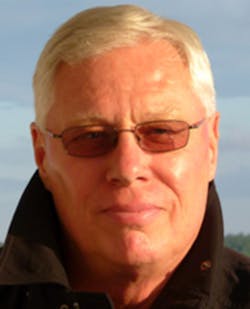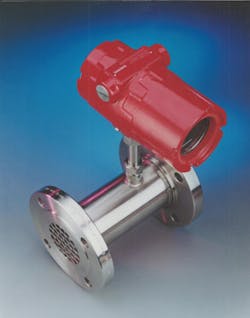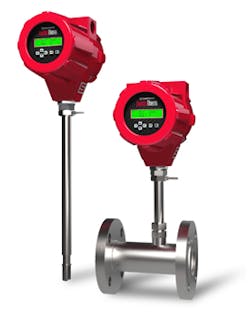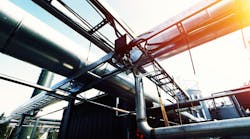John G. Olin, Ph.D., is the founder and chairman of Sierra Instruments, Inc., located in Monterey, Calif. Dr. Olin received his bachelor’s degree from Illinois Institute of Technology and his master’s and Ph.D. from Stanford University, all in Mechanical Engineering. At Stanford, Dr. Olin specialized in fluid mechanics and heat transfer and used hot-wire anemometers in research pursuant to his doctoral dissertation. He founded Sierra Instruments in 1973 with the purpose of offering industrial-grade thermal dispersion mass flowmeters to solve industry’s need for rugged, reliable flowmeters based on the thermal principle. Dr. Olin has a dozen patents and over 50 papers in the field.
Q: Your story and the birth of thermal flow measurement technology are very much intertwined. What role did you play in developing the initial concepts for thermal flow measurement?
A: Yes, you’re right, I’ve been focusing on thermal mass flow measurement for a very long time indeed. When I first started using this technology while at Stanford in the early ’60s getting my Ph.D. in mechanical engineering, this kind of instrument was called a "hot-wire anemometer." That’s the name given to it by its inventor, L.V. King, in 1914. These instruments worked successfully for fluid mechanics research, but were fragile and intended for laboratory use. I worked in this industry and learned that there is an unfulfilled and far bigger need for thermal mass flowmeters that are rugged and intended for general industrial applications.
I always had an entrepreneurial bent, so I hung up my own shingle and, in 1973, Sierra Instruments was founded. I had no money and little business experience, but that’s another story. The idea was to provide thermal dispersion mass flowmeters having the advantages of hot-wire anemometers, but with a robust industrial-grade sensor that could withstand the rigors of industrial applications. At that time there was only one other U.S. company and essentially zero foreign companies that had recognized this opportunity. In a few years following the conception of this idea, the basic sensor design had evolved into what is used today by most manufacturers—a self-heated platinum RTD winding on a ceramic mandrel that is encased in a rugged sealed metallic tube. In the usual configuration, a second sensor of similar design, but not self-heated, is located adjacent to the heated sensor and measures the temperature of the fluid. The instrument’s electronics maintain the difference in temperature between the heated sensor and the temperature sensor at a constant value, and the wattage required to do so gives you the mass flow output of the instrument (Figure 1). In almost all applications the fluid is a gas because the measurement sensitivity for liquids is too low.
So, getting back to your question, I guess I played a role in the industrialization of the technology. Initially, thermal dispersion mass flowmeters were configured as insertion meters. I also played an early role in adapting the technology to the more prevalent and more accurate in-line configuration with built-in flow conditioning. Along with other pioneers in the industry, I also was active in convincing the marketplace that thermal dispersion flowmeters do indeed directly measure mass flow rate. Believe me, it took years for this truth to gain the acceptance we now take for granted.
Q: Many of the folks who once worked with and for you have branched off to form their own thermal flow measurement companies. How do you feel about competing with so many folks who were once part of your team?
A: I often get asked, "How come so many companies making the same product as you are located near you in Monterey, California." The reason is simple—It’s the American dream to start your own company. I did it myself. There is no quicker way to success, but there is no harder way either. We have been in Monterey County since 1975. So, it’s no surprise that a few employees learned the trade from us and then branched off to start their own companies. Remember, we’re close to Silicon Valley, and start-ups are a way of life out here.
How do I feel about the spinoffs? I take pride that Sierra is the roots and the trunk of that tree and that we are the largest and best known manufacturer in the group.
Q: How has thermal flow measurement technology changed since it was originally conceived? What do you see as the key advances in the technology as it has evolved over the years?
A: The key advances in our technology begin with those I gave in my response above—industrial grade metal sheathed sensors; in-line flowmeters with built-in flow conditioning; and its acceptance as a flowmeter that legitimately measures mass flow rate. These advances were followed by a series of innovations in which Sierra played a major role, such as digital sensor drive; digital electronics; and mass flow sensors with high stability.
This latter advancement may be the most important of all. Traditionally in thermal dispersion mass flowmeters the heated sensor (the mass flow sensor) is constructed by inserting the platinum RTD winding into a tubular metallic sheath that contains a pool of cement that hardens and binds it to the I.D. of the sheath. This widely used sensor design can have problems because over time, and in the presence of variations in process gas temperature, the cement can crack or otherwise degrade. This causes measurement errors.
We solved this problem by eliminating the use of "wet" cement altogether and instead tightly swaging the metal sheath over the winding/mandrel assembly. This proprietary technology eliminates air gaps and makes the mass flow sensor exceptionally stable. We call it "DrySense" and guarantee its stability for 10 years.
Q: What are the most advantageous applications for thermal flow measurement technology? In what sort of scenarios do you see thermal flow measurement as the most logical solution?
A: Many of the advantages of thermal dispersion mass flowmeters have been there since the beginning:
- Direct measurement of mass flow rate
- High rangeability (1,000:1) and low-flow sensitivity
- Low pressure drop
- Low cost
The technology works for almost all industrial pure gases and gas mixtures, such as air, methane, natural gas, carbon dioxide, nitrogen, oxygen, argon, helium, hydrogen, stack gases, and bio gases. Some common applications are compressed air; wastewater treatment; combustion air and fuel gas; power plants; cogeneration; natural gas distribution and flaring; food and beverage production; semiconductor manufacturing; and HVAC.
Q: Sierra also offers ultrasonic and vortex-based flow measurement systems. Why does Sierra believe ultrasonic and vortex flow measurement systems are attractive technologies to offer?
A: The marketplace for flowmeters is highly fractionated. This is because no one technology solves all the applications. Each technology has its own "sweet spot" where it is best suited. This is in contrast with the field of, say, temperature measurement, which is well served by a couple of technologies—RTDs and thermocouples. Manufacturers with only one flowmeter technology naturally tend to extend it to applications where it does not belong and that are better served by alternative technology.
Sierra offers several flowmetering technologies so we can solve the flow measurement problems our customers have. Our thermal dispersion mass flowmeters are best suited for gas flow applications needing the features I just mentioned. Our vortex flowmeters are excellent for steam applications and higher flow rates of liquids. Our ultrasonic flowmeters are great for water flows and applications requiring a non-intrusive, low pressure drop flowmeter. Sierra also makes instruments based on the second kind of thermal technology—capillary tube thermal mass flowmeters and controllers. These thermal instruments are best suited for lower flows of clean gases used in semiconductor fabrication, vacuum processes, and a variety of light-duty applications.
Q: Going forward, what do you see as the most important trends in the area of flow measurement and control? How do you see broader trends in technology and applications influencing R&D efforts in the future?
A: In the flowmeter business there is an inexorable drive for higher accuracy. This is true because higher accuracy means customers can deliver their product with higher quality, less waste, and consequently higher profit. Thermal dispersion mass flowmeters have high repeatability, and, therefore, if the conditions in the field are close to those for which it was flow calibrated, high-end instruments have good accuracy. On this basis, most manufacturers specify an accuracy of about 1 percent of full scale. But, in the real world, the process temperature, process pressure, and ambient temperature in the field usually change—and accuracy suffers. As is to be expected, accuracy is also compromised if the gas itself changes. All of this is why the holy grail of our industry has always been: How is high accuracy maintained when things change?
I’ve been working on this problem for more years than I’d like to say. It has been a lot of hard work and long hours. I finally finished late last year, and Sierra introduced an advanced thermal dispersion mass flowmeter that manages these changes and delivers an accuracy of 0.5 percent of reading over the flow range of 50-100 percent of full scale, even when field conditions change (Figure 2). The new flowmeter is also multivariable (measures mass flow rate, process temperature, and optionally process pressure) and has a multi-gas capability for over 80 gases and gas mixtures that have their properties stored in embedded memory. This latter feature means it can handle applications where the gas composition is changing.
The new flowmeter is based on four technologies: The DrySense sensor that I mentioned before; a sensing head that has no flow interferences; the QuadraTherm design that has four temperature sensors instead of the traditional two; and the qTherm algorithm set that manages changing conditions and gas selection.
I think this new flowmeter is the next big thing in our industry.




